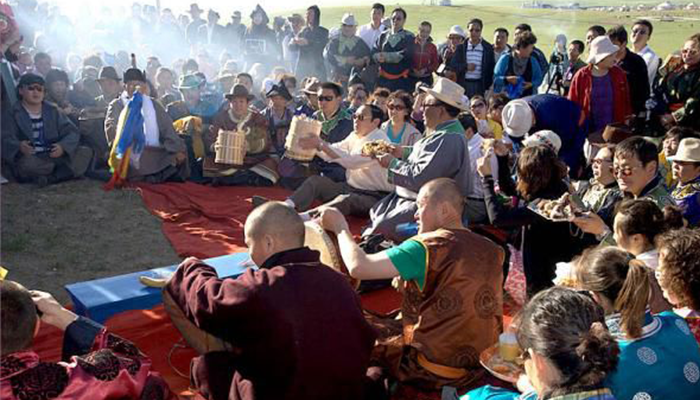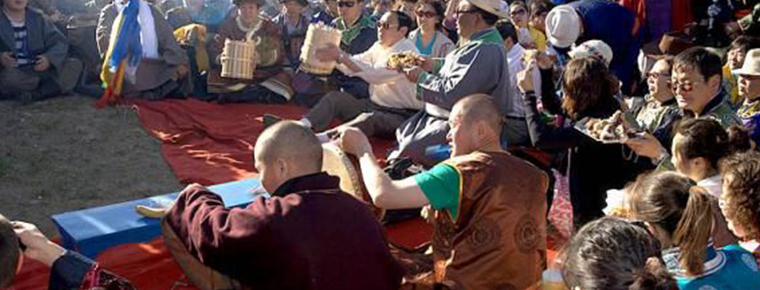Sebin Festival of Ewenki Nationality
Sebin Festival of Ewenki Nationality
"Serbin" is an Ewenki language, meaning "happy and peaceful". Sebin Festival is a traditional festival of the Ewenki people. On Sebin Festival, Ewenki hunters gather together. Celebrations will be held. All tribes, men, women, old and young, will be attended by Song, presided over by tribal chiefs. Simple hunters lit bonfires, sang and danced around them, offered sacrifices to the God Bayiannai, and held grand banquets. After the banquet, the hunters continued to dance until dawn the next day.
On May 23, 2011, the "Ewenki Sebin Festival" declared by Nehe City, Heilongjiang Province, was listed in the third batch of national intangible cultural heritage list with the approval of the State Council.
historical origin
Ewenki is one of the less populous ethnic groups in China. They live in the junction of Great Hinggan Mountains and Hulunbeir Grassland. They have their own language and no written language. Sebin Festival is an Ewenki language, meaning "happy and peaceful". It is reported that the current traditional Sebin Festival folk activities include worship of mountain gods, ethnic singing and dancing performances, traditional competitions, games, picnic wine banquets, bonfire parties, etc. Its customs are primitive and primitive, unique.
According to historical records, the ancestors of the Ewenki people, who lived by hunting, celebrated three days by singing and dancing every time they hunted such beasts as bears, which was the rudiment of the original Sabine Festival. But bears are not easy to catch, so the early Sebine Festival did not have a fixed time, and the content was relatively single because of the "bear sacrifice". Later, owing to the sharp decrease in the number of bears, the Ewenks began to hunt minks, deer and other animals. The Sebin Festival also gradually transited from bear sacrifice to mountain god sacrifice. Sabine Festival's sacrifices and carnivals are also constantly enriched, gradually increasing such content as imitating animal and bird singing and dancing performances, hunting, gathering and production of labor competitive games, as well as Bonfire Dance derived from heating carnival. With the development of the times, the religious color of today's Sebin Festival is gradually fading away, and gradually evolved into the annual grand carnival of the tribe.
Festival activities
Sebin Festival begins with sacrifice. Sacrifices are usually presided over by family, tribal leaders or tribal shamans, offering deer, cattle, sheep, horse milk and other sacrifices in front of mountain god tablets or Obo, in order to pray for good weather, prosperity of human beings and animals, and peace in all seasons. Following the sacrificial ceremony, songs and dances reflecting the Ewenki ethnic style and features and competitive activities have been launched one after another. During this period, a series of traditional performances, such as Luzhijile, Zandale and horse racing, archery, wrestling, were staged one by one. It was not until the beginning of the "picnic" that the traditional dance ended. On the "picnic of customs", the younger generation presents mare's milk to the elders, while the elder distributes auspicious gifts to the children. The picnic wine banquet will continue until the bonfire party, which is the last part of Sebin Festival and the climax of the festival. Men, women and children in the family or tribe are enjoying themselves by drinking, dancing around the campfire (also known as circle dance) and carnivalizing until dawn the next day.
Inheritance value
Ewenki is an ancient nation. They are Ewenki hunters living in big forests. Ewenki Autonomous Banner is located in the junction of Great Hinggan Mountains and Hulunbeir Grassland. Historically, Ewenki people who live in forests and hunt for a living have extremely harsh living conditions, but life can not always be in sorrow and pain. Therefore, they strive to create a happy, peaceful and happy living environment. They encourage each other in the national assembly, and they surround them. The bonfire sang and danced, and there was a carnival like Sebin's Day. In ancient times, Ewenki hunters gathered to celebrate the Sebin Festival. All the tribes, men, women, old and young, attended and were presided over by tribal chiefs. Simple hunters lit bonfires, sang and danced around them, offered sacrifices to the God Bayiannai, and held grand banquets. After the banquet, the hunters continued to dance until dawn the next day.
In the sixteenth century, "Shamanism" emerged among the Ewenki people, believing that "Shaman" was a "god" who could expel the evil ghosts of patients. Shamanism has spread to every clan, each clan has its own "Shaman". Since then, the Ewenki people began to believe in Shamanism, and the "Sebin Festival" characterized by totem has been lost for a time. However, since 1994, some folk festivals have been restored in the Ewenki Autonomous Banner of Inner Mongolia Autonomous Region. Sebin Festival is held on June 18 every year. Rainbow song is a Festival song of Ewenki Sebin Festival.
Inheritance and protection
In the 16th century, "Shamanism" emerged among the Ewenki people, believing that "Shaman" was a "god" who could expel the evil ghosts of patients. Shamanism has spread to all "Uriliang" (clan), each clan has its own "Shaman". Since then, the Ewenki people began to believe in Shamanism, and the "Sebin Festival" characterized by totem disappeared.
After the founding of the People's Republic of China, the people's government of Inner Mongolia Autonomous Region approved the restoration of the Ewenki ethnic name on March 5, 1958, abolished the nicknames "Solon", "Tungus", "Yakut" and so on, and the Ewenki ethnic group realized the unification of the ethnic name. The Ewenki Autonomous Banner was established on August 1, 1958 with the approval of the State Council. At the same time, the Ewenki people scattered in other places have established nine ethnic townships. In December 1984, the Ewenki Research Society of Inner Mongolia Autonomous Region was established. According to the requirements and wishes of the Ewenki people, the Ewenki Research Society of the Autonomous Region has consulted extensively on the name and time of Ewenki festivals, and the Ewenki Research Society of Heilongjiang Province has also participated in the discussion. At the third member congress of the Ewenki Research Association in the autonomous region, the name of "Sebin" was unanimously adopted as the Ewenki festival, and the festival time was set at June 18 each year. The Rainbow Song was tentatively designated as the Ewenki Festival song. The banner, the cadres and the masses of Ewenki nationality townships (Sumu, Ethnic Village and Gacha) were called upon to carry out festival activities at that time.


-
2.Weihai Liugong Island Scenic Area
WeihLiugong Island is located in Weihai Bay, the easternmost part of Shandong Peninsula. It has rich and unique cultural landscape, including the Warring States site dating back thousands of years
Time 2018-12-08 -
3.Nangong Scenic Spot
Located in Wangzou Town, Fengtai District, southwestern suburb of Beijing, Nangong Village, the village where the scenic spot is located, enjoys the reputation of "China's first geothermal villag
Time 2018-12-27 -
4.Jilin Beidahu Skiing Ground
Jilin Beidahu Skiing Ground is located in Jilin Beidahu Development Zone, 53 kilometers away from Jilin urban area. Entering the ski resort, facing the Asian Games Village Hotel.
Time 2019-01-19 -
5.Chishan Scenic Area Shidao
Chishan Scenic Area of Shidao, located in the Shidao Management Area of Rongcheng City, the easternmost end of Shandong Peninsula, is a national 4A-level tourist attraction
Time 2019-02-08 -
6.Tujia Style Garden
Zhangjiajie Tujia Style Park is located in Zhangjiajie City, a beautiful pearl. The Park covers an area of more than 80 mu with a total investment of 75 million yuan. It is a large-scale
Time 2019-02-22 -
7.Material liao qi
Material wares are traditional handicraft products in Beijing. It is a traditional handicraft made of glass strips. There was no direct glass-making industry in Beijing. The materials used were collec
Time 2019-05-13 -
8.A tune of mountain climbing
Mountain climbing tune, also known as mountain climbing song and mountain song, is a traditional short-tune folk song popular in the agricultural and semi-agricultural and semi-pastoral areas of centr
Time 2019-06-08 -
9.Zhoushan gongs and drums
Zhoushan gongs and drums are the representatives of traditional folk art in Zhoushan City, Zhejiang Province. They are based on gongs, drums, cymbals and clappers, with silk bamboo, magnificent sound
Time 2019-08-10 -
10.Kangding yak meat
There are many wild medicines such as Fritillaria, Cordyceps and so on growing in these areas over 3500 meters. Yaks often eat these herbs, and their meat is incomparably delicious. After being killed, they can be roasted in brown sauce, stewed or dried in the cold
Time 2020-12-06 -
11.Summary of Deyang
In 2018, Deyang's GDP reached 221.39 billion yuan, an increase of 9.0% over the previous year at comparable prices. The total economic output has exceeded 200 billion yuan, with per capita GDP of 62569 yuan. Among them, the added value of the primary industry
Time 2020-12-14 -
12.Meishan climate
Meishan city is located in the middle and low latitudes, located in the west of Sichuan Basin and the middle reaches of Minjiang River. It is characterized by the alternation of sea land monsoon every year. It has four distinct seasons, mild climate, abundant rainfall,
Time 2020-12-18